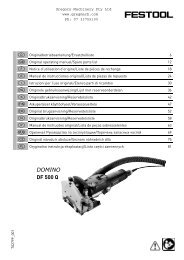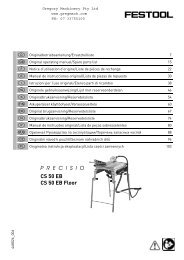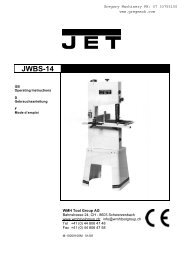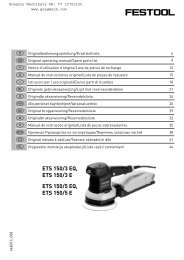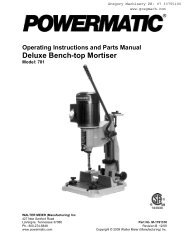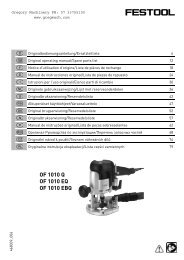Create successful ePaper yourself
Turn your PDF publications into a flip-book with our unique Google optimized e-Paper software.
Tool Talk<br />
The Laguna LT14 3000 <strong>Bandsaw</strong><br />
A <strong>Gutsy</strong><br />
14" <strong>Bandsaw</strong><br />
by Tom Caspar<br />
Resawing takes guts. It takes courage to<br />
saw a big, beautiful board in half—the guts<br />
to just go for it. Your bandsaw needs guts,<br />
too—the raw muscle to power through a<br />
huge cut.<br />
Although you may be up for the<br />
challenge, your saw may not. When<br />
we last tested 14" bandsaws, many felt<br />
underpowered when we resawed a very<br />
wide board. Since then, we’ve been<br />
searching for a 14" saw that would<br />
compare with the performance of a 16"<br />
or 18" saw, which can usually resaw wide<br />
boards with ease. Laguna Tools has been<br />
on a similar mission. They’ve developed a<br />
new 14" saw, the LT14 3000, that is truly<br />
built for resawing.<br />
Of course, we use bandsaws for much<br />
more than resawing, so it’s not the only<br />
criterion for choosing a saw. You may<br />
not need a lot of power—ever; but if<br />
you’re interested in a machine that can<br />
easily resaw wide panels as well as make<br />
smaller scrolling cuts, and is not as large<br />
or expensive as many 16" and 18" saws,<br />
read on.<br />
Capacity and power<br />
The LT14 3000 has a resawing capacity<br />
of 14" (Photo 1). The maximum capacity<br />
of a standard 14" cast iron saw is 6"; when<br />
you add a riser block, it's 12". If you’re<br />
fortunate enough to find a 12" to 14" wide<br />
board to cut open, the Laguna can handle<br />
it; a saw with a riser block can’t.<br />
Any saw that’s going to be used to rip<br />
boards this wide should have the power<br />
to match. Most 14" saws run on 120 volts.<br />
The largest motors on these saws typically<br />
photography: jason zentneR<br />
30 AmericanWoodworker.com december/january 2011
3<br />
Wide blades are best for resawing.<br />
This machine will accept a 1" blade; most<br />
14" bandsaws only take a 3/4" blade.<br />
1 2<br />
This machine’s resaw capacity is<br />
a huge 14". That’s 2" taller than the<br />
capacity of a 14" bandsaw with a riser<br />
block.<br />
Extra power is essential for resawing<br />
very wide boards. This saw has a rugged<br />
3 hp Leeson motor; most other 14" saws<br />
have 1-3/4 hp motors, at best.<br />
4<br />
Widely spaced ceramic guides keep<br />
a blade running true and cool, without<br />
twisting or bending.<br />
develop 1-3/4 hp, which is the most<br />
power you can wring from a 15<br />
amp circuit (the typical wiring in<br />
a small shop). In our experience,<br />
a 1-3/4 hp motor is adequate for<br />
resawing a 12" wide board, but you<br />
must proceed slowly and carefully<br />
to avoid bogging down the motor,<br />
which can lead to a wandering cut.<br />
More power really helps improve<br />
performance, and the LT14 3000<br />
has it (Photo 2). The saw comes in<br />
two versions: the STD (Standard),<br />
which has a 2hp 240V motor, and<br />
the SUV (Souped Up Version),<br />
which has a 3hp 240V motor. (We<br />
tested the SUV, and recommend<br />
its extra power.) Both motors are<br />
made by Leeson, a manufacturer<br />
with a long and solid track record.<br />
Blades and guides<br />
Successfully resawing wide boards<br />
also requires wide blades and<br />
large blade guides. Again, the<br />
LT14 3000 saws stand out against<br />
the field (Photo 3). These saws can<br />
handle blades up to 1" wide, while<br />
most other 14" saws take 3/4"<br />
blades, at most.<br />
The wider the blade, the<br />
greater its beam strength (beam<br />
strength is a blade’s resistance to<br />
bending when pushed straight<br />
back). Wide blades are more likely<br />
than narrow blades to produce<br />
a straight, perfectly vertical cut,<br />
and are preferred for resawing.<br />
The ability to make a straight cut<br />
is particularly important when<br />
you need a smooth, flat surface<br />
to maximize yield, or when you’re<br />
resawing a board into thin pieces<br />
of veneer.<br />
An important note about 3/4"<br />
and 1" blades for 14" saws: Don’t<br />
get one that’s .032" thick. Although<br />
it will work for a time, it may break<br />
prematurely from metal fatigue<br />
(.032" blades are OK for 16" and<br />
larger wheels, however). For 14"<br />
wheels, we recommend special<br />
3/4" or 1" blades that are .025"<br />
thick. These blades are available<br />
from Laguna (see Source, page<br />
xx).<br />
Laguna’s unique blade guide<br />
system helps keep the blade from<br />
twisting or bending during a heavy<br />
cut. It’s available on all of their<br />
saws, including the LT14 3000.<br />
Both the upper and lower guides<br />
are composed of pairs of ceramic<br />
blocks (Photo 4). These blocks<br />
are deep enough to completely<br />
support a 1" blade front to back,<br />
which prevents the blade from<br />
twisting. The blocks are also widely<br />
spaced apart, which prevents the<br />
blade from bending. Few—if any—<br />
14" saws have guides that offer<br />
this much support. Ball-bearing<br />
guides, which are becoming more<br />
common on bandsaws, may offer<br />
deep support from front to back,<br />
but don’t offer wide support top to<br />
bottom, as do the Laguna guides.<br />
The ceramic blocks in the<br />
Laguna guides are extremely hard<br />
and durable. They never need<br />
to be trued because they don’t<br />
wear down. However, you must be<br />
careful in adjusting them because<br />
the blocks could damage a blade’s<br />
teeth. Laguna recommends that<br />
you install a set of optional guides<br />
when using blades less than 1/4"<br />
wide. These guides use Cool<br />
Blocks, a phenolic material that<br />
won’t damage a blade’s teeth.<br />
Adjusting the Laguna guides<br />
requires using two hex wrenches<br />
and takes some patience. This<br />
adjustment system isn’t as userfriendly<br />
as the tool-free systems<br />
on some other 14" saws, but the<br />
Laguna guides do offer more<br />
support, which, for resawing, is<br />
more important than convenience.<br />
december/january2011 AmericanWoodworker.com 31
Tool Talk<br />
continued<br />
Rack and<br />
pinion<br />
7<br />
The fence can be angled for drift, which<br />
ensures a straight cut. Many fences<br />
on other bandsaws don’t have this<br />
important feature.<br />
5 6<br />
Robust construction leads to good<br />
performance. The guidepost hardly<br />
budges when you simulate the pressure<br />
of resawing by pushing on it.<br />
A wide table won’t budge when you<br />
push down, simulating the weight of a<br />
heavy timber. The table’s tilt is controlled<br />
by a stout rack-and-pinion mechanism.<br />
8<br />
Stepping on the saw’s footbrake turns<br />
off the power and quickly slows down<br />
the blade.<br />
Robust construction<br />
A good bandsaw needs heavy-duty<br />
construction to withstand the extra<br />
tension required by a wide blade.<br />
The sliding mechanism that allows<br />
the upper wheel to travel up and<br />
down, for example, must resist<br />
bending and twisting when the<br />
blade is tensioned. The LT14 3000<br />
mechanism, similar to that of larger<br />
Laguna bandsaws, is quite robust.<br />
Resawing also puts a lot of strain<br />
on the guidepost, the vertical arm<br />
that carries the upper blade guides.<br />
The Laguna guidepost rides in a<br />
heavy-duty carriage in the upper<br />
wheel housing, and this carriage<br />
resists backward and side-to-side<br />
pressure quite well (Photo 5).<br />
Wheels<br />
The LT14 3000 wheels are massive<br />
pieces of cast iron. Heavy wheels<br />
are desirable on a bandsaw—they<br />
dampen vibration and provide extra<br />
momentum for maintaining speed<br />
while cutting through a knot.<br />
The tires on the wheels are<br />
crowned—they’re higher in the<br />
center than on the edges. This<br />
design is common on 14" saws<br />
(larger saws generally have flat<br />
wheels), because it helps keep narrow<br />
blades centered on the wheel.<br />
Table and fence<br />
A machine designed for resawing<br />
needs a sturdy table to handle the<br />
weight of a heavy board. Laguna’s<br />
table doesn’t budge when you<br />
push down on one corner, as a test<br />
(Photo 6). Many other tables on<br />
14" saws don’t pass this test.<br />
The table is a generous 15"<br />
square, has a 90° stop, and can<br />
tilt 45° leaning away from the<br />
column and 15° leaning towards<br />
the column (just what you need for<br />
cutting dovetails, for instance—at<br />
least 10° tilt either way). The table<br />
stands only 35-1/2" from the floor,<br />
however. That’s a comfortable<br />
height for pushing a big, heavy<br />
board, but a bit low, we think, for<br />
scrolling cuts. The table on most<br />
14" bandsaws is about 44" high.<br />
If you want the Laguna’s table to<br />
be higher, you could place the<br />
machine on a box.<br />
The fence on this saw is as<br />
sturdy as the table. It’s unlikely to<br />
shift if you accidentally bang into it<br />
while positioning a large board for<br />
resawing, nor will it budge if you<br />
bear hard against it while pushing<br />
a board through the saw. It can<br />
also be angled for drift (Photo<br />
7), a feature you may need when<br />
using 1/2" or smaller blades. Stock<br />
fences on many 14" saws cannot be<br />
angled.<br />
Other features of the saw are<br />
worth mentioning, too: a footbrake,<br />
available only on the SUV (Photo<br />
8); a window for tracking the<br />
blade; a 4" dustport; and a quickacting<br />
blade release mechanism,<br />
which enables you to rapidly take<br />
the tension off the blade when the<br />
machine is not in use, and speeds<br />
up the process of changing blades.<br />
The bottom line<br />
Some tools break away from the<br />
pack when they’re pushed to the<br />
limits. For a bandsaw, the extreme<br />
test is resawing at maximum<br />
capacity. This machine, unlike<br />
many others, passes with flying<br />
colors.<br />
SOURCES<br />
Laguna Tools, www.lagunatools.com, (800)<br />
234-1976, LT14 3000, $995;<br />
LT14 SUV, $1,495.<br />
For reviews of bandsaws, go to<br />
AmericanWoodworker.com/WebExtras<br />
32 AmericanWoodworker.com december/january 2011




